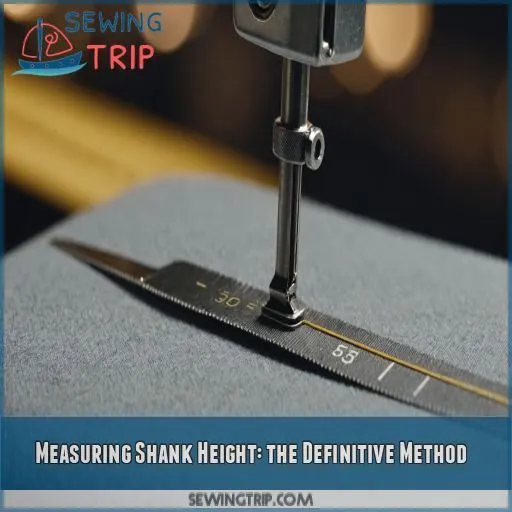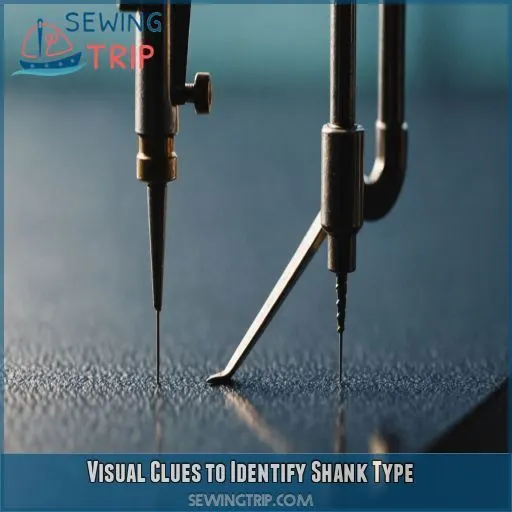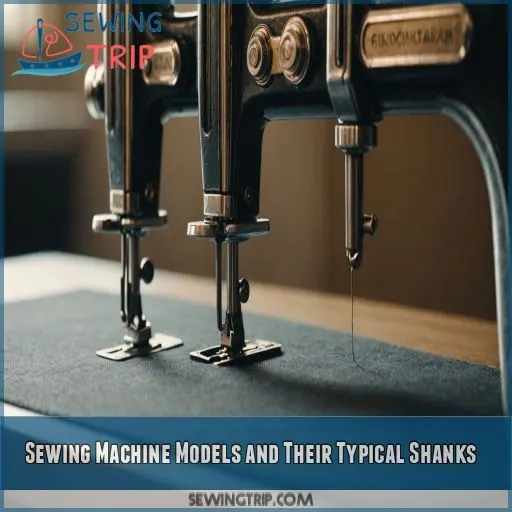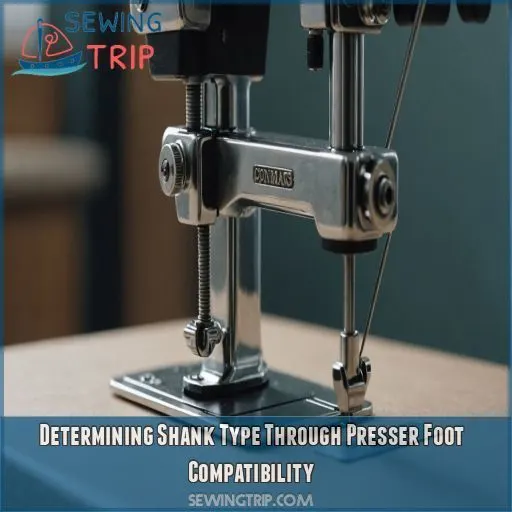This site is supported by our readers. We may earn a commission, at no cost to you, if you purchase through links.
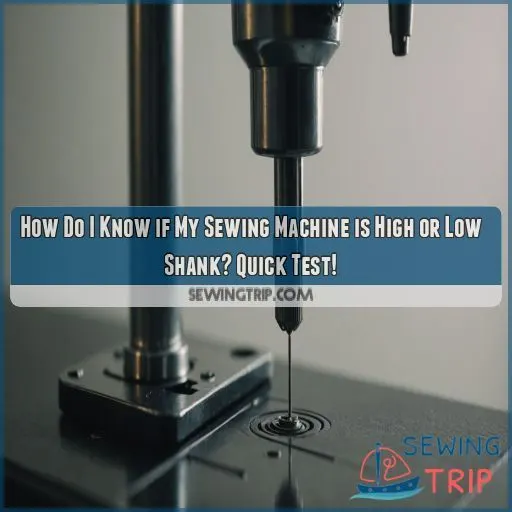
The quickest way is to measure the distance between the needle plate and the bottom of the presser foot holder. If it’s 3/4 inch or less, you’ve got a low shank. Over an inch? That’s a high shank.
No ruler handy? No worries! Visual clues can help too. Check out the presser foot holder shape: low shanks are flatter, while high shanks stand tall.
Your machine’s model can also be a telltale sign.
But here’s a secret: But here’s a secret: there’s a foolproof method involving your presser foot techniques that’ll make you feel like a sewing detective
.
Table Of Contents
Key Takeaways
- You’re not playing a guessing game – measuring is your best bet! Grab a ruler and measure from the needle plate to the bottom of the presser foot holder. If it’s 3/4 inch or less, you’ve got a low shank; over an inch means you’re in high shank territory.
- Your machine’s model can be a telltale sign. Most home sewing machines, including popular brands like Brother and Singer, typically have low shanks. But don’t assume – some high-end models break the mold with high shanks.
- Visual clues can help you play "shank detective." Low shanks often have flatter presser foot holders, while high shanks stand tall and proud. It’s like spotting the difference between a turtle’s neck and a giraffe’s.
- Presser foot compatibility is your secret weapon. If your feet are around 3/4 inch or shorter with a flat, rectangular attachment point, you’re likely working with a low shank machine. High shank feet are the tall, dark, and handsome type – about an inch long and often found on heavy-duty machines.
Measuring Shank Height: the Definitive Method
Wondering if your sewing machine is high or low shank, unlike Sewing Machine Features, which are straightforward, determining the shank type requires a different approach .
? You’re about to become a shank-measuring pro with our quick and foolproof method that’ll have you confidently identifying your machine’s shank type in no time.
Tools Needed for Measurement
Ready to play shank detective? You’ll need a trusty ruler or caliper, a measuring tape for backup, and a sewing gauge for precision. These tools are your high-low shank sleuths!
Step-by-Step Measurement Process
Ready to measure your sewing machine’s shank? Here’s your step-by-step guide:
- Grab your trusty ruler
- Lower the presser foot completely
- Measure from needle bed to presser foot holder
- Double-check for accuracy
- Record your measurement
Interpreting Measurement Results
You’ve measured your shank – now what? If it’s 0.75 inches or less, you’ve got a low shank. Anything over an inch? That’s high shank territory. Easy peasy!
Common Pitfalls in Measurement
Watch out for these snags when measuring your shank! You might place the ruler wrong, misread markings, or measure the wrong part. Don’t forget the thumb screw, and ditch that flimsy tape measure!
Visual Clues to Identify Shank Type
Imagine you’re a detective, Imagine you’re a detective, sleuthing out your sewing machine’s shank height measurement type.
. Here’s your visual evidence:
First, check the presser foot holder shape. A low shank often has a flatter, more compact design, while a high shank’s holder is typically taller and more elongated.
Next, scrutinize the needle plate design. Low shank machines usually have less space between the needle and the foot, while high shanks offer more clearance.
Look for shank size markings on your machine – some brands helpfully label this information.
The presser foot attachment method can also be a clue. Snap-on feet are often associated with low shanks, while screw-on feet are common in high shanks.
Sewing Machine Models and Their Typical Shanks
If you’re unsure about your sewing machine’s shank type, looking at common models like the Singer Sew Mate can be a helpful shortcut.
, looking at common models can be a helpful shortcut. Let’s explore some popular sewing machine brands and their typical shank types, so you can quickly pinpoint where your machine likely falls.
Brother Sewing Machines
brother sewing machines typically feature low shanks. You’ll find this true for most of their home models, making accessory shopping a breeze.
Singer Sewing Machines
Singer‘s been in the game since 1851. Their machines typically have low shanks, but some high-end models sport high shanks. Let’s break it down.
Janome Sewing Machines
Moving on from Singer, let’s talk Janome. You’ll find most Janome models sport a low shank, making them user-friendly for beginners and pros alike.
Bernina Sewing Machines
Bernina‘s unique! Unlike other brands, they’ve got their own clip-on system. Most models are high shank, but some older ones are low shank.
Pfaff Sewing Machines
Now, let’s talk Pfaff! These German-engineered beauties often sport a high shank, but don’t assume – some models break the mold. Let’s investigate!
Determining Shank Type Through Presser Foot Compatibility
If you’re stumped about your sewing machine’s shank type, don’t fret – your presser feet might hold the key! By examining the characteristics of your presser feet and testing their compatibility, you can quickly determine whether you’re working with a high or low shank machine.
Low Shank Presser Foot Characteristics
Now that we’ve covered common sewing machine models, let’s zoom in on low shank presser feet. These little guys are like the Goldilocks of the sewing world – not too tall, not too short.
- They’re usually around 3/4 inch or shorter
- Often have a flat, rectangular attachment point
- Come in both snap-on and screw-on varieties
- Typically fit most home sewing machines
- Can be used with low shank adapters for versatility
High Shank Presser Foot Characteristics
High shank presser feet are taller than their low shank cousins. You’ll notice they’re about an inch long – like a giraffe’s neck compared to a turtle’s! They’re often found on heavy-duty machines.
Universal Presser Feet and Adapters
Using universal presser feet can be a game-changer for your sewing adventures. You’ll find these versatile attachments and adapters can bridge the gap between high and low shank machines.
Testing Presser Foot Fit
Getting the right presser foot fit can feel like a sewing mystery! You’ll test compatibility like a detective. Here’s your quick checklist:
- Snap-on vs. Screw-on attachment
- Foot tension and stability
- Alignment with needle
- Smooth movement
Frequently Asked Questions (FAQs)
How do I know if I have a low shank or high shank sewing machine?
Sew, you’re in a stitch about your shank? To measure, lower the presser foot completely and check from its base to the screw center. If it’s 75" or less, you’ve got a low shank. Above 1" means high shank.
Are most sewing machines low shank?
Yes, most home sewing machines are low shank. You’ll find this common design in many popular brands. It’s like the "everyman" It’s like the "everyman" of sewing machines – versatile and Advanced Features & Versatility widely used.
. Don’t worry, you’re in good company!
Are Brother sewing machines low or high shank?
Most Brother sewing machines are low shank, but there are exceptions. You’ll want to measure from the needle plate to the screw hole – if it’s about 3/4 inch, you’ve got a low shank machine.
What is shank height sewing machine?
Shank height’s the distance from your sewing machine’s Main Sewing Machine needle plate to the presser foot holder
. It’s like your machine’s secret handshake – knowing it helps you pick the right accessories. You’ll find low, high, or slant shanks.
Can I convert my low shank to high shank?
Yes, you can convert your low shank to high shank using an adapter. It’s like giving your sewing machine a growth spurt! This nifty tool allows you to use high shank presser feet on your low shank machine.
Do all modern sewing machines use low shanks?
No, not all modern sewing machines use low shanks. While low shanks are common in home machines, you’ll find high shanks in some newer models, especially those designed for heavy-duty work or commercial use. It’s best to check your specific model.
How does shank type affect stitch quality?
Shank type doesn’t directly affect stitch quality. It’s more about compatibility and functionality. You’ll notice differences in fabric handling and accessory options. High shanks offer more clearance, while low shanks are common in home machines. Choose wisely for your sewing needs!
Are there universal presser feet for all shanks?
You’ll find universal snap-on presser feet that fit various shanks, but they often need adapters. For a perfect fit, you’ll want to match your machine’s shank type. It’s like finding the right dance partner for your sewing machine!
Does shank type influence machine price and durability?
Yes, shank type affects price and durability. High shank machines are typically pricier but more robust, built for heavy-duty work. Low shank models are usually more affordable and suitable for home use, offering good durability for everyday sewing tasks.
Conclusion
Knowing your sewing machine’s shank type is like figuring out a secret sewing superpower!
It helps you determine if your machine is high or low shank.
Measuring is foolproof, but visual clues and presser foot compatibility can also guide you.
Don’t let shank confusion hold you back from exploring new presser feet and techniques.
With this knowledge, you’ll confidently answer "how do I know if my sewing machine is high or low shank?" and take your sewing projects to new heights.
Happy stitching!

